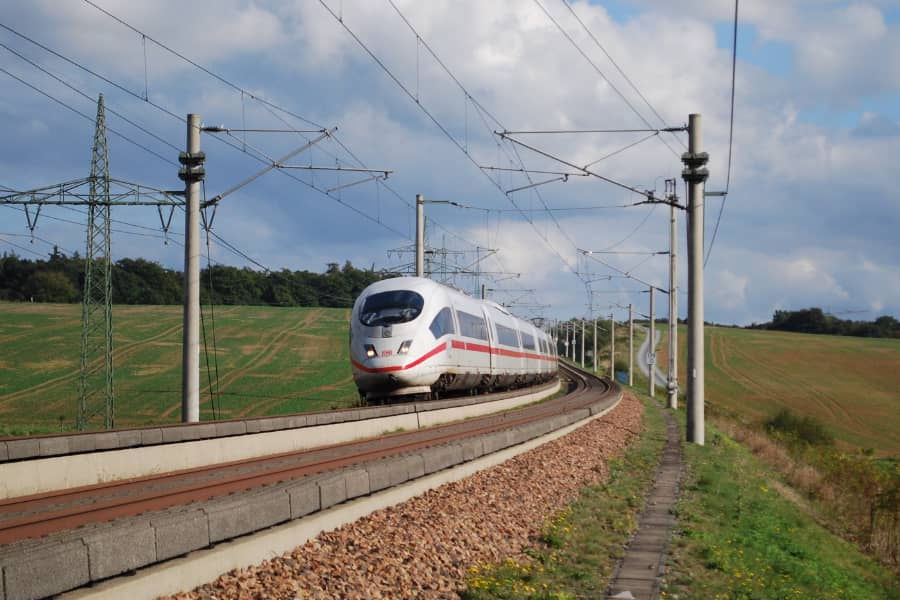Indiana: Made for High-Speed Rail
Indiana is the “Cross Roads of America.” It plays a critical role in linking the Midwest to the Atlantic Coast.
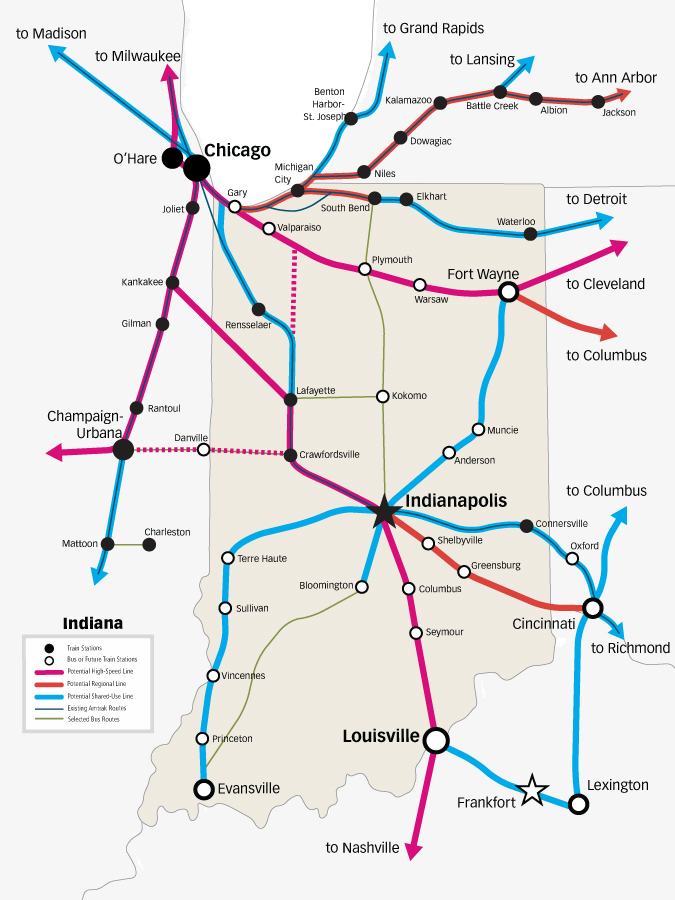
A Long Range Vision
Indiana is special for two main reasons.
1) Indianapolis is centrally located, surrounded by many nearby cities and towns.
2) The Fort Wayne Line, running next to Route 30, is a critical link between the Midwest and East Coast in a national, high-speed rail network.
Indiana has made a first step towards a modern passenger rail network by expanding the South Shore. It’s time for a statewide program.
Indianapolis
Indianapolis’s location in the heart of a population-dense, resource-rich region could be a competitive advantage. A high-speed rail hub would make the city a premiere destination in a way that it’s never been.
Consider the numbers: 55 million people live within 300 miles of Indianapolis. That’s nearly twice the number of people living within 300 miles of “buzzy” cities like Austin and Los Angeles (29 million and 30 million people, respectively). And it blows away most other major cities, including Atlanta (37 million), Charlotte (36 million), Phoenix (16 million), and Seattle (12 million).
What’s more, several of the nation’s largest cities could be within an easy, two-hour ride of Indianapolis on a high-speed train.
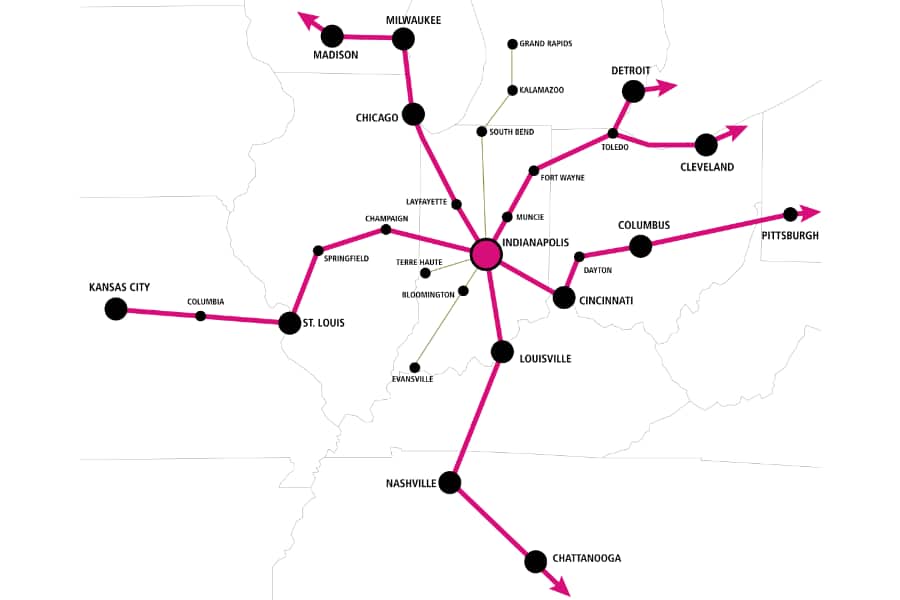
There are more than 20 medium to large cities within a 300-mile radius of Indianapolis. (Only routes directly connected to Indianapolis are pictured above)
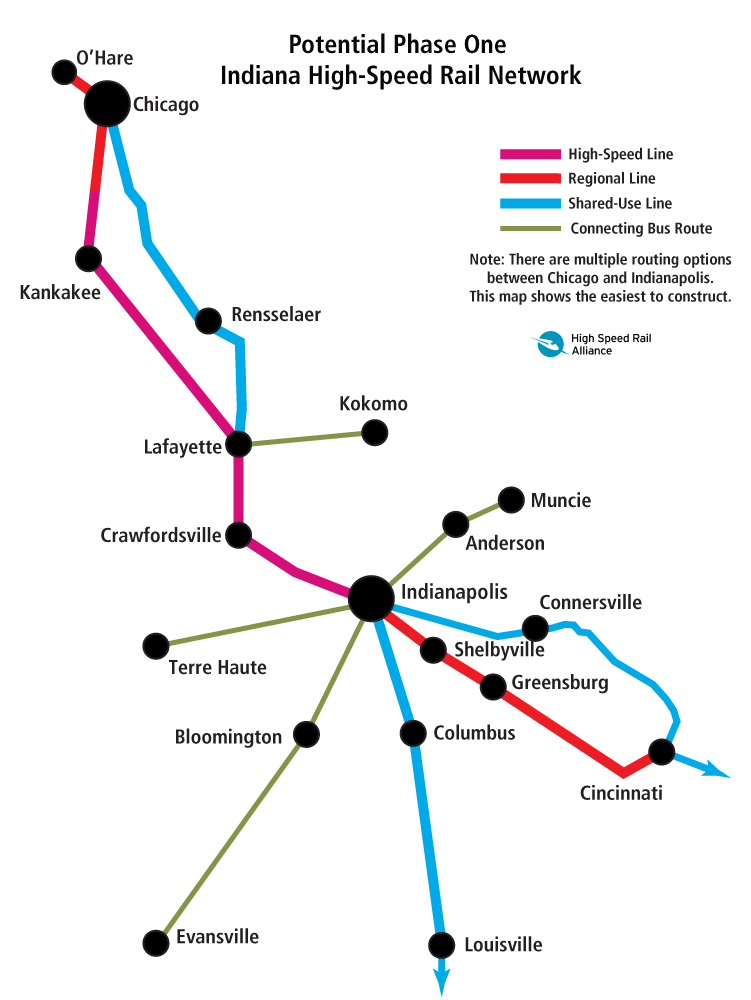
A high-speed line from Chicago to Indianapolis, linked to upgraded routes to Cincinnati and Louisville, would dramatically collapse travel times in the region – with an impact reaching into Ohio and Kentucky.
A Great Proof of Concept
Indianapolis to Chicago is an ideal place to demonstrate the power of high-speed trains.
At 200 miles, it is long enough to show what high-speed rail can do, but short enough that it’s a bite-sized, demonstrator segment.
High-speed trains would cut the 3.5 hour drive down to just 90 minutes. A direct connection to O’Hare would give Indianapolis businesses more options for reaching international markets. The additional volumes brought by high-speed trains would make upgrades to feeder lines more feasible.
Amtrak has proposed upgrading the existing CSX tracks for eight daily roundtrip trains between Chicago and Indianapolis. Trip time would be in the 3.5 to 4 hour range. Four would continue to Louisville and four to Cincinnati. The State of Indiana should aggressively pursue this as a quick-start project while design work begins for a 220-mph high-speed line.
South of the Lake Reroute
The most important segment of a high-speed rail network is a dedicated, double-track bypass running from Porter, IN to Chicago.
The Michigan Department of Transportation has already done initial research into this new route, but the Indiana Department of Transportation should aggressively move forward with the project.
There is also a workable interim solution: Without waiting for the high-speed bypass above, Amtrak could add new daily departures by using the South Shore Line, which is adding a second track to its line from Michigan City to Gary and a new route to Dyer, IN. That upgrade, which is already underway, will dramatically increase the capacity for passenger trains.
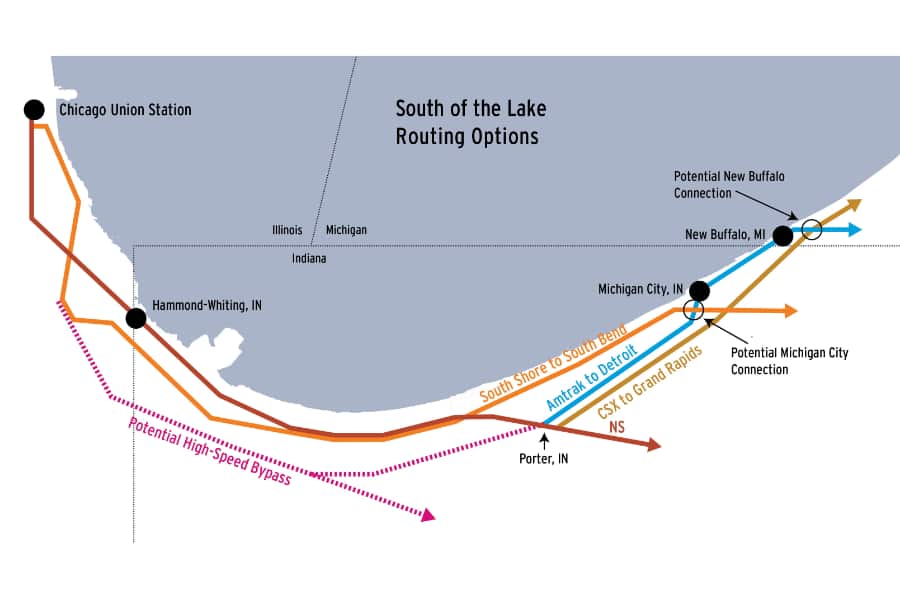
The Fort Wayne Line: A Critical Link
Built To Go Fast
Another essential corridor is the Fort Wayne Line of the former Pennsylvania Railroad.
It is a nearly arrow-straight right-of-way from Tolleston, IN to Lima, OH, passing through Fort Wayne. It is owned by CSX and leased to the Chicago, Fort Wayne and Eastern.
It could play a major role in a national high-speed rail network.
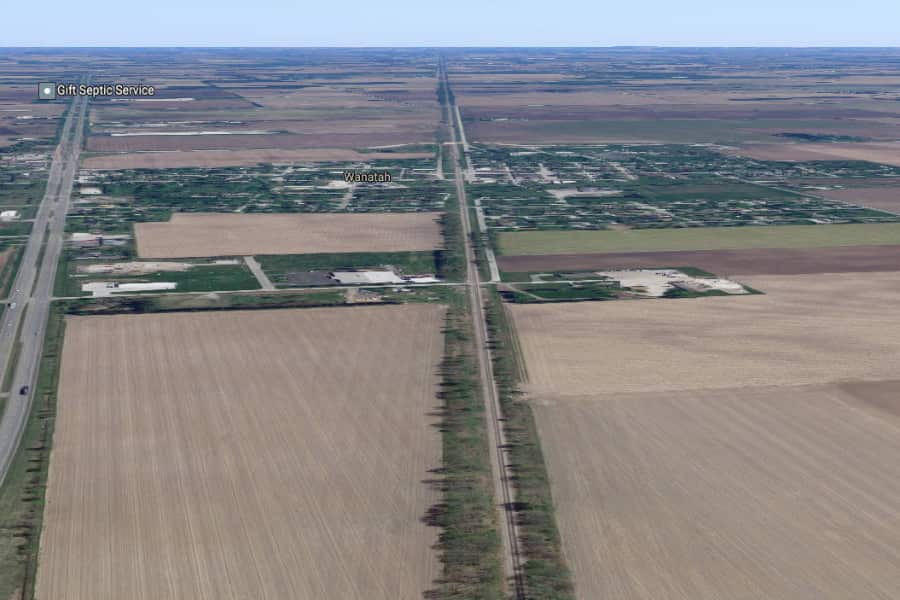
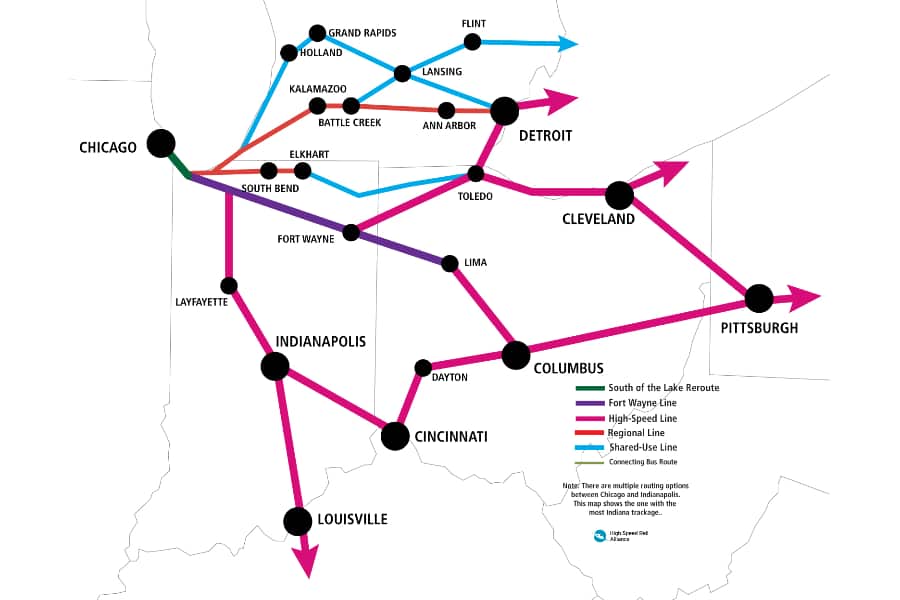
Importance
Upgrading the Fort Wayne Line with two electrified high-speed tracks and a separate freight track should be a national priority.
It would be an important first segment of a major high-speed artery from Chicago to the East Coast.
South Shore double tracking
The Northern Indiana Commuter Transportation District is double tracking the South Shore railroad from Gary to Michigan City. Currently this is a single-track railroad which limits capacity and flexibility in case of bad weather or mechanical issues on a train. Completion is set for 2024. Travel times between Michigan City and Millennium Station Chicago will be reduced by 30 minutes, and the improvements will allow adding 14 daily roundtrips.
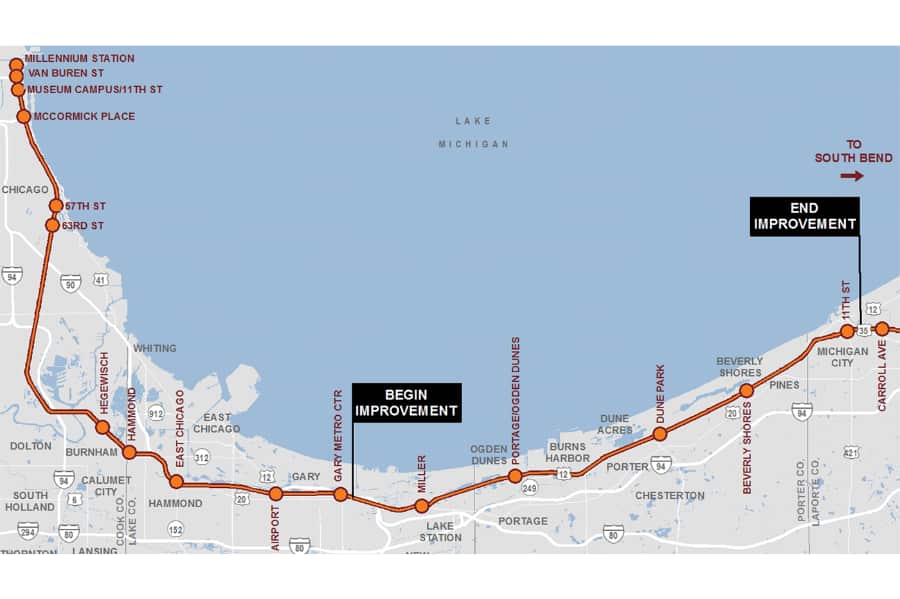
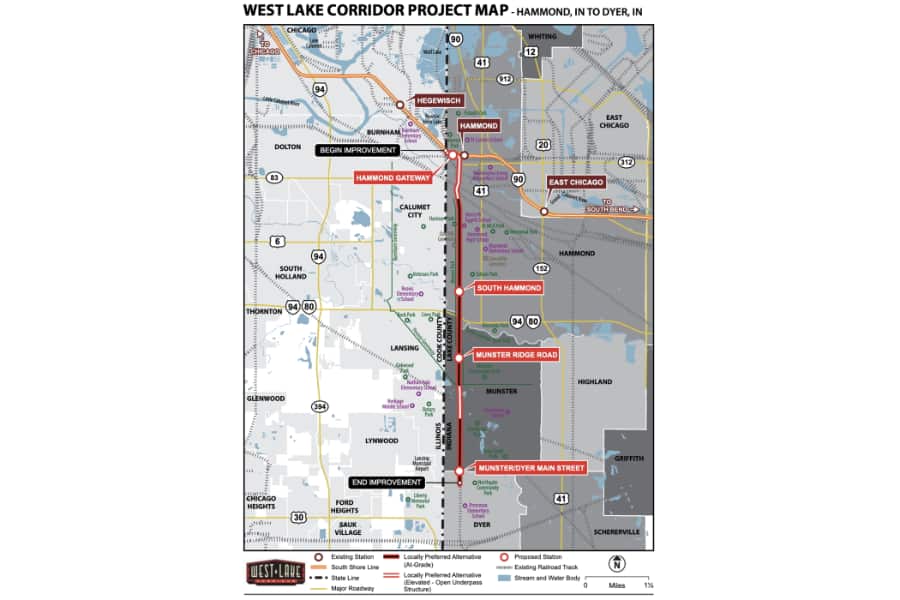
West Lake Corridor
NICTD is also building a new branch to Dyer, IN.
There will be five round trips a day to Chicago offering one-seat rides and local shuttle trains to connecting trains at Hammond throughout the day.
This could be the foundation for new conventional service to Indianapolis.
Indiana Needs a Statewide Rail Plan
To make all of this happen, high-speed rail in Indiana needs to be embedded in a statewide plan – as California has done – integrating rail, transit, and buses into a cohesive system delivering fast, affordable, convenient, and frequent travel to everyone.
With the U.S. poised to invest heavily in railroads over the near term—and with HSR and transit systems growing at an explosive rate globally—Indiana has a great opportunity to reinvent and reinvigorate its economy.
It’s been done before, when automobiles connected the nation and built the foundation of America’s middle class wih good-paying jobs.
It can be done again—but better, with 21st-century transportation technology that connects families and communities, fosters innovation and economic vitality, and builds on a storied past.
It’s a bold plan for a thriving heartland. What are you waiting for, Indiana?
